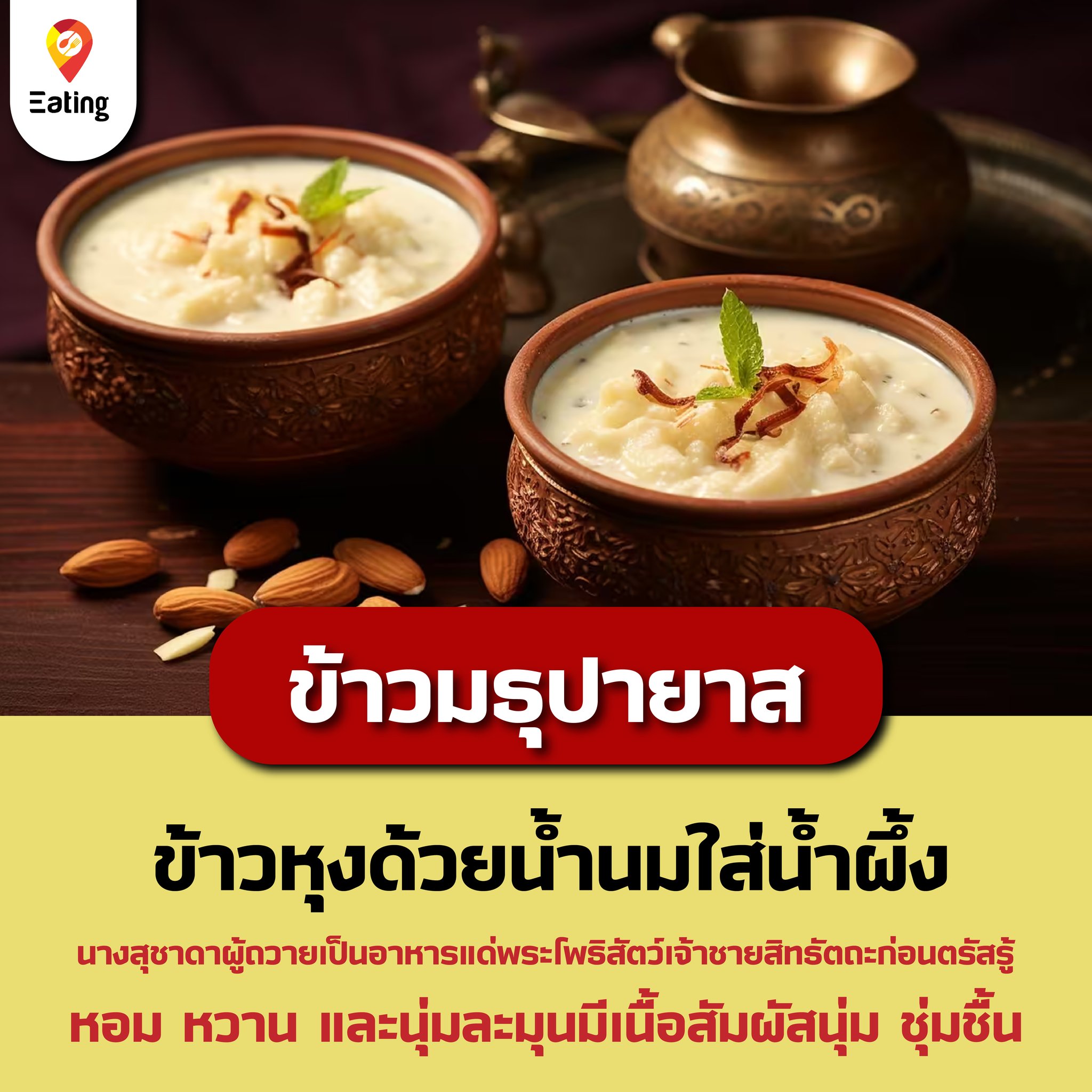Insider
New Experience

ข้าวมธุปายาส
ข้าวหุงด้วยน้ำนมใส่น้ำผึ้ง
ข้าวมธุปายาสเป็นอาหารที่มีความสำคัญในประวัติศาสตร์และวัฒนธรรมของพุทธศาสนา โดยเป็นข้าวที่หญิงชื่อ "สุชาดา" ถวายแด่พระสิทธัตถะ โคตมะ (พระพุทธเจ้า) ก่อนที่พระองค์จะตรัสรู้
.
ขณะนั้นพระพุทธเจ้ามีดำริว่าจะบำเพ็ญเพื่อการตรัสรู้ ณ ต้นโพธิพฤกษ์และประทับนั่งโคนต้นไม้หันพระพักตร์สู่ทิศตะวันออก นางสุชาดาและนางทาสีมาถึงได้พบพระพุทธเจ้าครั้งแรกเข้าใจว่าเป็นรุกขเทพเจ้าจำแลงเพศ เกิดความเลื่อมใสจึงน้อมถาดข้าวมธุปายาสเข้าไปถวายแก้สัจกิริยาท่านได้บนบานไว้ พระพุทธเจ้าจึงตรัสขอบคุณต่อนาง และบอกแก่นางว่าพระองค์ท่านมิได้เป็นเทพยดา แต่เป็นมนุษย์คือเป็นกษัตริย์แห่งเมืองกบิลพัสดุ์ออกผนวช เพื่อแสวงหาสัจธรรม นางสุชาดาทราบเรื่องแล้ว ก็กราบถวายบังคมลากลับบ้านเรือนของตน
.
หลังจากนั้นพระพุทธเจ้าทรงนำเอาข้าวจากถาดมาทรงทำเป็นก้อนๆ นับจำนวนได้ 49 ก้อน ให้เป็นเครื่องรำลึกถึงวันที่ทรงบำเพ็ญทุกกิริยา เสวยข้าวมธุปายาส 49 ก้อนนั้นหมดแล้ว ทรงนำถาดไปทรงอธิฐานในแม่น้ำเนรัญชรา และทรงอธิฐานว่าถ้าหากพระองค์จะได้ตรัสรู้ก็ขอให้ถาดทองนั้นลอยทวนน้ำขึ้นไป
.
เมื่อพระองค์ทรงวางถาดลงในน้ำ ก็ปรากฏว่า ถาดทองลอยทวนน้ำขึ้นเหนือน้ำดังคำอธิฐาน ซึ่งพระองค์ทรงถือว่าภัตตาหารมื้อนั้นได้มีส่วนทำให้พระองค์ตรัสรู้อริยสัจ 4 บรรลุอนุตรสัมมาสัมโพธิญาณ
.
ด้วยรำลึกถึงพระพุทธองค์และเหตุการณ์สำคัญนี้ พุทธศาสนิกชนจึงนิยมทำข้าวมธุปายาสในวันวิสาขบูชา เกิดเป็น “ประเพณีกวนข้าวมธุปายาส” หรือที่คนไทยนิยมเรียกกันคุ้นหูว่า “ประเพณีกวนข้าวทิพย์” โดยเชื่อกันว่าการได้ถวายเป็นพุทธบูชาจะนำความสุขสวัสดีและบุญกุศลแก่ตน
.
ข้าวมธุปายาสทำจากข้าวที่หุงกับน้ำนมและน้ำผึ้ง ให้รสหวาน หอม มักเสิร์ฟในโอกาสสำคัญทางศาสนาและพิธีกรรมต่าง ๆ เนื่องจากเป็นสัญลักษณ์แห่งการตื่นรู้และความเมตตา นอกจากนี้ยังเป็นสัญลักษณ์ของความสมบูรณ์และความอุดมสมบูรณ์ที่มาพร้อมกับความอ่อนโยน ข้าวมธุปายาสยังถูกนำมาใช้ในการประกอบพิธีทางศาสนาในวันสำคัญ เช่น วันมาฆบูชา วันวิสาขบูชา หรือในเทศกาลที่เกี่ยวข้องกับการน้อมบูชาพระพุทธเจ้า
.
-------------------------------------------------------------
The dish "Mathupayas" holds significant importance in the history and culture of Buddhism. It refers to the rice that a woman named Sujata offered to Siddhartha Gautama (the Buddha) before he attained enlightenment.
At that time, the Buddha intended to practice meditation for enlightenment under the Bodhi tree and was seated at its base facing east. Sujata and her maid came across the Buddha for the first time and mistook him for a tree deity. Filled with reverence, she offered him a bowl of Mathupayas rice in fulfillment of a vow she had made. The Buddha thanked her and explained that he was not a deity but a human being, a prince from Kapilavastu who had renounced the world in search of truth. After hearing this, Sujata paid her respects and returned home.
The Buddha then divided the rice into 49 pieces to commemorate the days of his ascetic practices. After consuming the 49 portions, he took the bowl to the Neranjara River and made a vow, asking that if he was destined to attain enlightenment, the golden bowl should float upstream.
When he placed the bowl in the water, it floated against the current as he had vowed. The Buddha believed that this meal had contributed to his realization of the Four Noble Truths and the attainment of supreme enlightenment.
In remembrance of this event, Buddhists make Mathupayas on Vesak Day, giving rise to the tradition known as the "Mathupayas Stirring Ceremony," or as it is commonly referred to in Thailand, the "Divine Rice Stirring Ceremony." It is believed that offering this dish as a tribute to the Buddha brings blessings and merit.
Mathupayas is made from rice cooked with milk and honey, giving it a sweet, fragrant taste. It is often served during religious ceremonies and rituals, symbolizing enlightenment and compassion. It also represents abundance and gentleness. The dish is used in various religious ceremonies, especially on important days like Magha Puja, Vesak Day, or festivals related to honoring the Buddha.
ขอขอบคุณข้อมูลจาก https://www.pptvhd36.com/.../%E0%B9%84%E0%B8%A5%E0.../223760